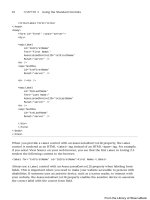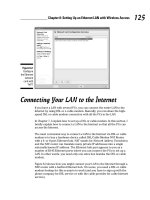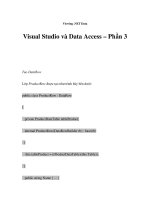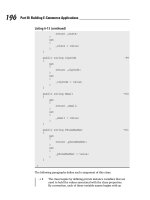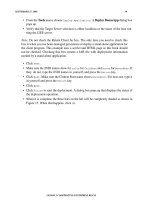ASP.NET at Work: Building 10 Enterprise Projects PHẦN 6 docx
Bạn đang xem bản rút gọn của tài liệu. Xem và tải ngay bản đầy đủ của tài liệu tại đây (529.99 KB, 64 trang )
</td>
<td nowrap align=”right”>
<%# DataBinder.Eval(Container.DataItem, “TimeGenerated”, _
“{0:MM-dd-yyyy HH:mm:ss}”) %>
</td>
</tr>
<tr>
<td colspan=”3”>
<%# GetHtmlMessage(Container.DataItem) %>
</td>
</tr>
</table>
</itemtemplate>
<separatortemplate>
<hr width=”100%” noshade size=”1”>
</separatortemplate>
</asp:datalist>
</td>
</tr>
</table>
</form>
</body>
</html>
Listing 5.2 HTML for ErrorManager/Default.aspx (continued)
This page sets up an ASP:DataList Web server control to display the entries con-
tained in the event log, if the event log is installed.
Next, switch to the code-behind file, and type the complete listing shown in Listing
5.3 (do not modify the Web Forms Designer generated code section, however).
Option Strict On
Option Explicit On
Imports System.Diagnostics
Namespace ErrorManager
Public Class DefaultPage
Inherits System.Web.UI.Page
Protected WithEvents EMDataList As System.Web.UI.WebControls.DataList
Protected WithEvents EMClear As System.Web.UI.WebControls.Button
Protected WithEvents EMEvents As _
System.Web.UI.HtmlControls.HtmlTableRow
Protected WithEvents EMStatus As System.Web.UI.WebControls.Label
Private blnInstalled As Boolean = HasErrorManager()
Private Sub Page_Load(ByVal sender As System.Object, _
Listing 5.3 Code for ErrorManager/Default.aspx.vb
Building the ASP.NET Error Manager 303
ByVal e As System.EventArgs) Handles MyBase.Load
Dim evtEM As EventLog
‘
‘ If the custom event log is not installed, do
‘ not show the data list or the “Clear” button.
‘
If blnInstalled = False Then
EMStatus.Text = “The ASP.NET Error Manager is currently “ & _
“NOT installed.”
EMEvents.Visible = False
EMClear.Visible = False
Return
End If
‘
‘ Otherwise, show both and bind the data list
‘ to the event log entries collection.
‘
EMStatus.Text = “The ASP.NET Error Manager is currently installed.”
EMEvents.Visible = True
EMClear.Visible = True
evtEM = New EventLog(“ASP.NET Error Manager”)
EMDataList.DataSource = evtEM.Entries
EMDataList.DataBind()
evtEM.Dispose()
End Sub
‘
‘ This method is used as a check to
‘ see if the custom event log exists.
‘
Friend Function HasErrorManager() As Boolean
Return EventLog.Exists(“ASP.Net Error Manager”)
End Function
‘
‘ This method converts NewLines in the event log
‘ entry message into <br> tags so they will look
‘ at least somewhat formatted.
‘
Protected Function GetHtmlMessage(ByVal item As Object) As String
Dim entry As EventLogEntry
If TypeOf item Is EventLogEntry Then
entry = CType(item, EventLogEntry)
Listing 5.3 Code for ErrorManager/Default.aspx.vb (continued)
304 Project 5
Return entry.Message.Replace(Environment.NewLine, “<br>”)
End If
End Function
‘
‘ This method is used to clear
‘ the event log of all entries.
‘
Private Sub EMClear_Click(ByVal sender As Object, _
ByVal e As System.EventArgs) Handles EMClear.Click
Dim evtEM As EventLog
evtEM = New EventLog(“ASP.NET Error Manager”)
evtEM.Clear()
EMDataList.DataSource = evtEM.Entries
EMDataList.DataBind()
evtEM.Dispose()
End Sub
End Class
End Namespace
Listing 5.3 Code for ErrorManager/Default.aspx.vb (continued)
That’s all there is to it. You now have all the necessary code to view and clear your
custom event log. When the page loads, the first thing it does is check to see if the event
log exists. If not, it will make both the button used to clear the log and the data list that
is used to display it invisible (thus removing it from the HTML output).
After that initial check, it binds the data list to the EventLog Entries property, which
contains the collection of individual entries, and then releases any unmanaged
resources that may be held by the evtEM event log component.
Of course, you could make this as fancy as you want by adding the Error, Warning,
and Information graphics, and sorting, filtering, and paging to the data list, but I’ll
leave that to your capable hands.
The next step is to add a plain text file to this directory that can hold our email tem-
plate. Right-click the ErrorManager directory, and select Add —> Add New Item. Then
select the text file template, name it ErrorEMail.txt, and click OK.
Type the following text in the file, and save it. This will be the default email that is
sent to an administrator when a site failure occurs.
<html>
<head>
<title>An Error Occurred On Your Site</title>
Building the ASP.NET Error Manager 305
<style>
body {
font-family: Verdana;
font-size: 10pt;
}
table {
font-family: Verdana;
font-size: 10pt;
}
</style>
</head>
<body>
<p>A visitor encountered an error while browsing your site. The visitor
was successfully redirected to a custom error page and did not see the
details of the error.</p>
<p>The error details are as follows:</p>
<blockquote>%CUSTOM_INSERT%</blockquote>
<p>Please correct the cause of this error as soon as possible.</p>
<p><font size=”2”>THIS MESSAGE WAS SENT BY AN AUTOMATED SYSTEM. DO
NOT REPLY.</font></p>
</body>
</html>
Next, we’ll tackle the custom error pages in HTTP status code order . . .
Building the Error/Denied Page
This is the page that visitors will see when they attempt to access a protected resource
with incorrect authorization. Select the Error folder in Solution Explorer, right-click it,
and select Add —> New Web Form. Name the page Denied.aspx, and then click Open.
Switch to HTML view for the Denied.aspx page, and type the code as it is shown in
Listing 5.4.
<%@ Page Language=”vb” AutoEventWireup=”false”
Codebehind=”Denied.aspx.vb”
Inherits=”Project05.Error.Denied” %>
<!DOCTYPE HTML PUBLIC “-//W3C//DTD HTML 4.0 Transitional//EN”>
<html>
<head>
<title>Access to the requested page was denied </title>
<meta name=”GENERATOR” content=”Microsoft Visual Studio.NET 7.0”>
<meta name=”CODE_LANGUAGE” content=”Visual Basic 7.0”>
<meta name=”vs_defaultClientScript” content=”JavaScript”>
<meta name=”vs_targetSchema”
Listing 5.4 HTML for Error/Denied.aspx
306 Project 5
content=” /><link rel=”stylesheet” href=” /Styles.css”>
</head>
<body ms_positioning=”FlowLayout”>
<form id=”Denied” method=”post” runat=”server”>
<table cellpadding=”0” cellspacing=”0” border=”0” width=”100%”
height=”100%”>
<tr>
<td valign=”top” align=”middle” height=”42”>
<h1>
Access to the requested page was denied
</h1>
</td>
</tr>
<tr>
<td valign=”top”>
<p>
Some parts of this site are secured and are therefore not
available to the general public. If you have received this
message in error, our site administrators have already been
notified and will correct the problem as soon as possible.
</p>
<p>
<asp:label id=”ContactUs” runat=”server”
font-size=”1.3em”>Please feel free to contact our customer
service department regarding this issue at
<nobr>1-800-555-5555</nobr>, or use the form below to send
us an <nobr>e-mail</nobr> message.</asp:label>
</p>
</td>
</tr>
<tr>
<td valign=”top” align=”middle”>
<table cellpadding=”0” cellspacing=”5” border=”0”
id=”EMailForm” runat=”server”>
<tr>
<td colspan=”3”>
<asp:validationsummary id=”Summary” runat=”server”
displaymode=”BulletList”
headertext=”Please correct the following and try again:”
showsummary=”True”></asp:validationsummary>
</td>
</tr>
<tr>
<td>
E-Mail Address:
</td>
<td>
<asp:textbox id=”EMailFrom” runat=”server”
maxlength=”255” width=”3in”></asp:textbox>
Listing 5.4 HTML for Error/Denied.aspx (continued)
Building the ASP.NET Error Manager 307
</td>
<td>
<asp:requiredfieldvalidator id=”EMailFromRequired”
runat=”server” controltovalidate=”EMailFrom”
errormessage=”Your e-mail address is required for reply”
display=”Static”>*</asp:requiredfieldvalidator>
</td>
</tr>
<tr>
<td>
Subject:
</td>
<td>
<asp:textbox readonly=”True” id=”EMailSubject”
runat=”server” maxlength=”255”
width=”3in”></asp:textbox>
</td>
<td rowspan=”3”>
</td>
</tr>
<tr>
<td valign=”top”>
Message:
</td>
<td valign=”top”>
<asp:textbox id=”EMailMessage” runat=”server”
rows=”10” textmode=”MultiLine”
width=”3in”></asp:textbox>
</td>
</tr>
<tr>
<td colspan=”2” align=”right”>
<asp:button id=”SendButton” runat=”server”
text=”Send Now”></asp:button>
</td>
</tr>
</table>
<table cellpadding=”0” cellspacing=”0” border=”0”
align=”center” id=”SuccessNotice” runat=”server”>
<tr>
<td>
Your message was sent successfully. In 10 seconds,
you will be redirected to the public home page.
If the redirect does not work, please use the link
at the bottom of this page.
</td>
</tr>
</table>
</td>
Listing 5.4 HTML for Error/Denied.aspx (continued)
308 Project 5
</tr>
<tr>
<td valign=”bottom” align=”middle”>
<a href=”/default.aspx”>Return to the public home page</a>
</td>
</tr>
</table>
</form>
</body>
</html>
Listing 5.4 HTML for Error/Denied.aspx (continued)
This page explains to users that parts of the site are secure and that an administrator
has been notified of the access attempt, and gives the visitor an opportunity to contact
customer service regarding this event.
The code-behind for this page is shown in Listing 5.5.
Option Strict On
Option Explicit On
Imports System.Web.Mail
Namespace [Error]
Public Class Denied
Inherits System.Web.UI.Page
Protected WithEvents Summary As _
System.Web.UI.WebControls.ValidationSummary
Protected WithEvents EMailFrom As System.Web.UI.WebControls.TextBox
Protected WithEvents EMailFromRequired As _
System.Web.UI.WebControls.RequiredFieldValidator
Protected WithEvents EMailSubject As System.Web.UI.WebControls.TextBox
Protected WithEvents EMailMessage As System.Web.UI.WebControls.TextBox
Protected WithEvents ContactUs As System.Web.UI.WebControls.Label
Protected WithEvents EMailForm As System.Web.UI.HtmlControls.HtmlTable
Protected WithEvents SuccessNotice As _
System.Web.UI.HtmlControls.HtmlTable
Protected WithEvents SendButton As System.Web.UI.WebControls.Button
Private Sub Page_Load(ByVal sender As System.Object, _
ByVal e As System.EventArgs) Handles MyBase.Load
Dim strTo As String
SuccessNotice.Visible = False
‘
Listing 5.5 Code for Error/Denied.aspx.vb
Building the ASP.NET Error Manager 309
‘ If we’re not set up to send e-mail, don’t offer it.
‘
strTo = CStr(Application(“CustomerServiceEMail”))
If strTo = Nothing Then
ContactUs.Text = “Please feel free to contact our “ & _
“customer service department regarding this issue at “ & _
“<nobr>1-800-555-5555</nobr>.”
EMailForm.Visible = False
Return
End If
EMailSubject.Text = “Access Denied to Page “”” & _
Request.QueryString(“aspxerrorpath”) & “”””
If Not Page.IsPostBack Then
‘
‘ Pre-validate so the asterisk shows up.
‘
EMailFromRequired.Validate()
Summary.Visible = False
Else
If Not Page.IsValid Then
Summary.Visible = True
Return
End If
End If
End Sub
‘
‘ This sends the e-mail and then notifies the visitor and redirects
‘ them to the default page.
‘
Private Sub SendButton_Click(ByVal sender As Object, _
ByVal e As System.EventArgs) Handles SendButton.Click
Dim strTo As String
Dim emlMsg As MailMessage
Dim emlSender As SmtpMail
strTo = CStr(Application(“CustomerServiceEMail”))
If Not strTo = Nothing Then
emlMsg = New MailMessage()
emlMsg.To = CStr(Application(“CustomerServiceEMail”))
emlMsg.From = EMailFrom.Text.Trim()
emlMsg.Subject = EMailSubject.Text
emlMsg.BodyFormat = MailFormat.Text
emlMsg.Body = EMailMessage.Text
Listing 5.5 Code for Error/Denied.aspx.vb (continued)
310 Project 5
Try
emlSender = New SmtpMail()
Try
emlSender.Send(emlMsg)
‘
‘ If the mail was sent successfully, redirect
‘ back to the home page after 10 seconds.
‘
Response.AppendHeader(“Refresh”, _
“10;URL=/Project05/Default.aspx”)
EMailForm.Visible = False
SuccessNotice.Visible = True
Catch
End Try
Finally
emlSender = Nothing
End Try
End If
End Sub
End Class
End Namespace
Listing 5.5 Code for Error/Denied.aspx.vb (continued)
This code sets up the visual details of the page based upon the server configura-
tion’s current capabilities and then responds when the Send Now button is clicked.
The square brackets around the namespace name Error are required
because Error is a reserved keyword. You can use keywords as
parameters, properties, method names, and so on as long as they are
qualified in this way.
Building the Error/NotFound Page
This page is almost identical to the Denied page, with some minor changes in the
wording in the page. Within the Error directory, add another Web Forms page named
NotFound.aspx, and in HTML view, type the code shown in Listing 5.6.
<%@ Page Language=”vb” AutoEventWireup=”false”
Codebehind=”NotFound.aspx.vb”
Inherits=”Project05.Error.NotFound” %>
Listing 5.6 HTML for Error/NotFound.aspx
Building the ASP.NET Error Manager 311
<!DOCTYPE HTML PUBLIC “-//W3C//DTD HTML 4.0 Transitional//EN”>
<html>
<head>
<title>The page you were looking for was not found </title>
<meta name=”GENERATOR” content=”Microsoft Visual Studio.NET 7.0”>
<meta name=”CODE_LANGUAGE” content=”Visual Basic 7.0”>
<meta name=”vs_defaultClientScript” content=”JavaScript”>
<meta name=”vs_targetSchema”
content=” /><link rel=”stylesheet” href=” /Styles.css”>
</head>
<body ms_positioning=”FlowLayout”>
<form id=”NotFound” method=”post” runat=”server”>
<table cellpadding=”0” cellspacing=”0” border=”0” width=”100%”
height=”100%”>
<tr>
<td valign=”top” align=”middle” height=”42”>
<h1>
The page you were looking for was not found
</h1>
</td>
</tr>
<tr>
<td valign=”top”>
<p>
Like any popular Internet property, this site is always
under construction. Sometimes when we make these changes
our customers temporarily find some broken links in our
site. Our site administrators are now aware that
the page you were looking for is not available and may
implement an automatic redirect to the correct page.
</p>
<p>
<asp:label id=”ContactUs” runat=”server”
font-size=”1.3em”>Let us help you find what you were
looking for by using the form below to send us an e-mail.
Alternatively, you may contact our customer service
department at <nobr>1-800-555-5555</nobr>.</asp:label>
</p>
</td>
</tr>
<tr>
<td valign=”top” align=”middle”>
<table cellpadding=”0” cellspacing=”5” border=”0”
id=”EMailForm” runat=”server”>
<tr>
<td colspan=”3”>
<asp:validationsummary id=”Summary” runat=”server”
displaymode=”BulletList”
headertext=”Please correct the following and try again:”
Listing 5.6 HTML for Error/NotFound.aspx (continued)
312 Project 5
TEAMFLY
Team-Fly
®
showsummary=”True”></asp:validationsummary>
</td>
</tr>
<tr>
<td>
E-Mail Address:
</td>
<td>
<asp:textbox id=”EMailFrom” runat=”server”
maxlength=”255” width=”3in”></asp:textbox>
</td>
<td>
<asp:requiredfieldvalidator id=”EMailFromRequired”
runat=”server” controltovalidate=”EMailFrom”
errormessage=”Your e-mail address is required for reply”
display=”Static”>*</asp:requiredfieldvalidator>
</td>
</tr>
<tr>
<td>
Subject:
</td>
<td>
<asp:textbox readonly=”True” id=”EMailSubject”
runat=”server” maxlength=”255”
width=”3in”></asp:textbox>
</td>
<td rowspan=”3”>
</td>
</tr>
<tr>
<td valign=”top”>
Message:
</td>
<td valign=”top”>
<asp:textbox id=”EMailMessage” runat=”server”
rows=”10” textmode=”MultiLine”
width=”3in”></asp:textbox>
</td>
</tr>
<tr>
<td colspan=”2” align=”right”>
<asp:button id=”SendButton” runat=”server”
text=”Send Now”></asp:button>
</td>
</tr>
</table>
<table cellpadding=”0” cellspacing=”0” border=”0”
align=”center” id=”SuccessNotice” runat=”server”>
Listing 5.6 HTML for Error/NotFound.aspx (continued)
Building the ASP.NET Error Manager 313
<tr>
<td>
Your message was sent successfully. In 10 seconds,
you will be redirected to the public home page. If
the redirect does not work, please use the link at the
bottom of this page.
</td>
</tr>
</table>
</td>
</tr>
<tr>
<td valign=”bottom” align=”middle”>
<a href=”/default.aspx”>Return to the public home page</a>
</td>
</tr>
</table>
</form>
</body>
</html>
Listing 5.6 HTML for Error/NotFound.aspx (continued)
The complete listing for the associated code-behind file is shown in Listing 5.7.
Option Strict On
Option Explicit On
Imports System.Web.Mail
Namespace [Error]
Public Class NotFound
Inherits System.Web.UI.Page
Protected WithEvents ContactUs As System.Web.UI.WebControls.Label
Protected WithEvents Summary As _
System.Web.UI.WebControls.ValidationSummary
Protected WithEvents EMailFrom As System.Web.UI.WebControls.TextBox
Protected WithEvents EMailFromRequired As _
System.Web.UI.WebControls.RequiredFieldValidator
Protected WithEvents EMailSubject As System.Web.UI.WebControls.TextBox
Protected WithEvents EMailMessage As System.Web.UI.WebControls.TextBox
Protected WithEvents EMailForm As System.Web.UI.HtmlControls.HtmlTable
Protected WithEvents SuccessNotice As _
System.Web.UI.HtmlControls.HtmlTable
Protected WithEvents SendButton As System.Web.UI.WebControls.Button
Private Sub Page_Load(ByVal sender As System.Object, _
ByVal e As System.EventArgs) Handles MyBase.Load
Listing 5.7 Code for Error/NotFound.aspx.vb
314 Project 5
Dim strTo As String
SuccessNotice.Visible = False
‘
‘ If we’re not set up to send e-mail, don’t offer it.
‘
strTo = CStr(Application(“CustomerServiceEMail”))
If strTo = Nothing Then
ContactUs.Text = “Our customer service department can be “ & _
“contacted at <nobr>1-800-555-5555</nobr> and would be “ & _
“happy to help you find what you were looking for.”
EMailForm.Visible = False
Return
End If
EMailSubject.Text = “File Not Found Looking For “”” & _
Request.QueryString(“aspxerrorpath”) & “”””
If Not Page.IsPostBack Then
‘
‘ Pre-validate so the asterisk shows up.
‘
EMailFromRequired.Validate()
Summary.Visible = False
Else
If Not Page.IsValid Then
Summary.Visible = True
Return
End If
End If
End Sub
‘
‘ This sends the e-mail and then notifies the visitor and redirects
‘ them to the default page.
‘
Private Sub SendButton_Click(ByVal sender As Object, _
ByVal e As System.EventArgs) Handles SendButton.Click
Dim strTo As String
Dim emlMsg As MailMessage
Dim emlSender As SmtpMail
strTo = CStr(Application(“CustomerServiceEMail”))
If Not strTo = Nothing Then
emlMsg = New MailMessage()
emlMsg.To = CStr(Application(“CustomerServiceEMail”))
emlMsg.From = EMailFrom.Text.Trim()
Listing 5.7 Code for Error/NotFound.aspx.vb (continued)
Building the ASP.NET Error Manager 315
emlMsg.Subject = EMailSubject.Text
emlMsg.BodyFormat = MailFormat.Text
emlMsg.Body = EMailMessage.Text
Try
emlSender = New SmtpMail()
Try
emlSender.Send(emlMsg)
‘
‘ If the mail was sent successfully, redirect
‘ back to the home page after 10 seconds.
‘
Response.AppendHeader(“Refresh”, _
“10;URL=/Project05/Default.aspx”)
EMailForm.Visible = False
SuccessNotice.Visible = True
Catch
End Try
Finally
emlSender = Nothing
End Try
End If
End Sub
End Class
End Namespace
Listing 5.7 Code for Error/NotFound.aspx.vb (continued)
Building the Error/Problem Page
Users will see this page if an untrapped error occurs within any page on the site. This
is similar to the other error pages, again with some changes in wording. Select the
Error directory, and add a new Web Forms page named Problem.aspx. Switch to
HTML view, and type the code as shown in Listing 5.8.
<%@ Page Language=”vb” AutoEventWireup=”false”
Codebehind=”Problem.aspx.vb” Inherits=”Project05.Error.Problem” %>
<!DOCTYPE HTML PUBLIC “-//W3C//DTD HTML 4.0 Transitional//EN”>
<html>
<head>
Listing 5.8 HTML for Error/Problem.aspx
316 Project 5
<title>We are experiencing a problem with our site </title>
<meta name=”GENERATOR” content=”Microsoft Visual Studio.NET 7.0”>
<meta name=”CODE_LANGUAGE” content=”Visual Basic 7.0”>
<meta name=”vs_defaultClientScript” content=”JavaScript”>
<meta name=”vs_targetSchema”
content=” /><link rel=”stylesheet” href=” /Styles.css”>
</head>
<body ms_positioning=”FlowLayout”>
<form id=”Problem” method=”post” runat=”server”>
<table cellpadding=”0” cellspacing=”0” border=”0” width=”100%”
height=”100%”>
<tr>
<td valign=”top” align=”middle” height=”42”>
<h1>
We’re sorry, but
</h1>
<h3>
we seem to be having a problem with our site.
</h3>
</td>
</tr>
<tr>
<td valign=”top”>
<p>
<asp:label id=”ContactUs” runat=”server”
font-size=”1.3em”>If this problem persists, please contact
our customer service department at
<nobr>1-800-555-5555</nobr> or use the form below to
e-mail our customer service and information technology
help desks. Please note that the error has been recorded,
and a site administrator has been dispatched to correct
it.</asp:label>
</p>
</td>
</tr>
<tr>
<td valign=”top” align=”middle”>
<table cellpadding=”0” cellspacing=”5” border=”0”
id=”EMailForm” runat=”server”>
<tr>
<td colspan=”3”>
<asp:validationsummary id=”Summary” runat=”server”
displaymode=”BulletList”
headertext=”Please correct the following and try again:”
showsummary=”True”></asp:validationsummary>
</td>
</tr>
Listing 5.8 HTML for Error/Problem.aspx (continued)
Building the ASP.NET Error Manager 317
<tr>
<td>
E-Mail Address:
</td>
<td>
<asp:textbox id=”EMailFrom” runat=”server”
maxlength=”255” width=”3in”></asp:textbox>
</td>
<td>
<asp:requiredfieldvalidator id=”EMailFromRequired”
runat=”server” controltovalidate=”EMailFrom”
errormessage=”Your e-mail address is required for reply”
display=”Static”>*</asp:requiredfieldvalidator>
</td>
</tr>
<tr>
<td>
Subject:
</td>
<td>
<asp:textbox readonly=”True” id=”EMailSubject”
runat=”server” maxlength=”255”
width=”3in”></asp:textbox>
</td>
<td rowspan=”3”>
</td>
</tr>
<tr>
<td valign=”top”>
Message:
</td>
<td valign=”top”>
<asp:textbox id=”EMailMessage” runat=”server”
rows=”10” textmode=”MultiLine”
width=”3in”></asp:textbox>
</td>
</tr>
<tr>
<td colspan=”2” align=”right”>
<asp:button id=”SendButton” runat=”server”
text=”Send Now”></asp:button>
</td>
</tr>
</table>
<table cellpadding=”0” cellspacing=”0” border=”0”
align=”center” id=”SuccessNotice” runat=”server”>
<tr>
<td>
Listing 5.8 HTML for Error/Problem.aspx (continued)
318 Project 5
Your message was sent successfully. In 10 seconds, you
will be redirected to the public home page. If the
redirect does not work, please use the link at the
bottom of this page.
</td>
</tr>
</table>
</td>
</tr>
<tr>
<td valign=”bottom” align=”middle”>
<a href=”/default.aspx”>Return to the public home page</a>
</td>
</tr>
</table>
</form>
</body>
</html>
Listing 5.8 HTML for Error/Problem.aspx (continued)
The code-behind for this page is shown in Listing 5.9 (except for the Web Forms
Designer Generated Code, which should not be modified).
Option Strict On
Option Explicit On
Imports System.Web.Mail
Namespace [Error]
Public Class Problem
Inherits System.Web.UI.Page
Protected WithEvents ContactUs As System.Web.UI.WebControls.Label
Protected WithEvents Summary As _
System.Web.UI.WebControls.ValidationSummary
Protected WithEvents EMailFrom As System.Web.UI.WebControls.TextBox
Protected WithEvents EMailFromRequired As _
System.Web.UI.WebControls.RequiredFieldValidator
Protected WithEvents EMailSubject As System.Web.UI.WebControls.TextBox
Protected WithEvents EMailMessage As System.Web.UI.WebControls.TextBox
Protected WithEvents SendButton As System.Web.UI.WebControls.Button
Protected WithEvents EMailForm As System.Web.UI.HtmlControls.HtmlTable
Protected WithEvents SuccessNotice As _
System.Web.UI.HtmlControls.HtmlTable
Private Sub Page_Load(ByVal sender As System.Object, _
ByVal e As System.EventArgs) Handles MyBase.Load
Listing 5.9 Code for Error/Problem.aspx.vb
Building the ASP.NET Error Manager 319
Dim strTo As String
SuccessNotice.Visible = False
‘
‘ If we’re not set up to send e-mail, don’t offer it.
‘
strTo = CStr(Application(“CustomerServiceEMail”))
If strTo = Nothing Then
ContactUs.Text = “If this problem persists, please contact “ & _
“our customer service department at “ & _
“<nobr>1-800-555-5555</nobr>.”
EMailForm.Visible = False
Return
End If
EMailSubject.Text = “Internal Server Error In “”” & _
Request.QueryString(“aspxerrorpath”) & “”””
If Not Page.IsPostBack Then
‘
‘ Pre-validate so the asterisk shows up.
‘
EMailFromRequired.Validate()
Summary.Visible = False
Else
If Not Page.IsValid Then
Summary.Visible = True
Return
End If
End If
End Sub
‘
‘ This sends the e-mail and then notifies the visitor and redirects
‘ them to the default page.
‘
Private Sub SendButton_Click(ByVal sender As Object, _
ByVal e As System.EventArgs) Handles SendButton.Click
Dim strTo As String
Dim emlMsg As MailMessage
Dim emlSender As SmtpMail
strTo = CStr(Application(“CustomerServiceEMail”))
If Not strTo = Nothing Then
emlMsg = New MailMessage()
emlMsg.To = CStr(Application(“CustomerServiceEMail”))
Listing 5.9 Code for Error/Problem.aspx.vb (continued)
320 Project 5
emlMsg.From = EMailFrom.Text.Trim()
emlMsg.Subject = EMailSubject.Text
emlMsg.BodyFormat = MailFormat.Text
emlMsg.Body = EMailMessage.Text
Try
emlSender = New SmtpMail()
Try
emlSender.Send(emlMsg)
‘
‘ If the mail was sent successfully, redirect
‘ back to the home page after 10 seconds.
‘
Response.AppendHeader(“Refresh”, _
“10;URL=/Project05/Default.aspx”)
EMailForm.Visible = False
SuccessNotice.Visible = True
Catch
End Try
Finally
emlSender = Nothing
End Try
End If
End Sub
End Class
End Namespace
Listing 5.9 Code for Error/Problem.aspx.vb (continued)
Now that you’re finished with the subdirectories, let’s go ahead and secure the
ErrorManager directory and then add error handling to the Global.asax code.
Setting the Configuration
Open the Web.config file in the Source Code window, and locate the customErrors tag.
This tag should read as follows:
<customErrors mode=”RemoteOnly” />
This means that visitors from any computer other than “localhost” will see a
stripped-down error page, while you will see the source code where the error occurred,
the stack trace, and so on.
Building the ASP.NET Error Manager 321
In order to test our custom error pages, change the line shown previously to read as
follows:
<customErrors mode=”On” defaultRedirect=”/Project05/Error/Problem.aspx”>
<error statusCode=”403” redirect=”/Project05/Error/Denied.aspx” />
<error statusCode=”404” redirect=”/Project05/Error/NotFound.aspx” />
<error statusCode=”500” redirect=”/Project05/Error/Problem.aspx” />
</customErrors>
That’s all there is to implementing custom error pages. The error pages can be ASP,
aspx, htm, and so on, and can be branded to appear consistent with the rest of your site.
Now let’s secure the ErrorManager directory so that only administrators can access
the Event Log. Then you’ll add your custom application-specific settings to the config-
uration file. Move to the bottom of this file, and between the </system.web> and
</configuration> tags add the following code, replacing the values “email.address@
domain.com” with your own email address.
</system.web> <! This is already here, don’t add >
<location path=”ErrorManager”>
<system.web>
<authorization>
<allow roles=”BUILTIN\Administrators” />
<deny users=”*” />
</authorization>
</system.web>
</location>
<! Custom application-specific settings
for the ASP.NET Error Manager >
<appSettings>
<add key=”AdministratorEMail” value=”” />
<add key=”CustomerServiceEMail” value=”” />
<add key=”ErrorManagerEventLog” value=”ASP.NET Error Manager” />
</appSettings>
</configuration> <! This is already here, don’t add >
By inserting this location tag, you can override the default configuration for specific
subdirectories. It is available for use in the ASP.NET configuration files as well as in the
rest of the .NET runtime, including Windows Forms applications and the like. By mak-
ing this change, we are overriding the default authorization configuration to specify
that members of the BUILTIN\Administrators groups are permitted to access that
directory, while everyone else is denied.
Now, save the Web.config file, and open the Global.asax file in code view.
Adding Global Error Handling
at the Application Level
The Global.asax file is the second line of defense against errors, but it is also the last
place where the exception that caused the error is available. The first line of defense is
322 Project 5
TEAMFLY
Team-Fly
®
in the page itself, and the last is in the pages specified in the <customErrors> section of
the configuration file.
With the Global.asax file open in code view, modify it so that it contains the code
shown in Listing 5.10 (leaving the Component Designer Generated Code section alone).
Option Strict On
Option Explicit On
Imports System.Web
Imports System.Web.Mail
Imports System.Web.SessionState
Imports System.Text
Imports System.Diagnostics
Imports System.Configuration
Imports System.IO
Public Class Global
Inherits System.Web.HttpApplication
#Region “ Component Designer Generated Code “
Public Sub New()
MyBase.New()
‘This call is required by the Component Designer.
InitializeComponent()
‘Add any initialization after the InitializeComponent() call
End Sub
Friend WithEvents EMEventLog As System.Diagnostics.EventLog
‘Required by the Component Designer
Private components As System.ComponentModel.Container
‘NOTE: The following procedure is required by the Component Designer
‘It can be modified using the Component Designer.
‘Do not modify it using the code editor.
<System.Diagnostics.DebuggerStepThrough()> Private Sub
InitializeComponent()
Me.EMEventLog = New System.Diagnostics.EventLog()
CType(Me.EMEventLog,
System.ComponentModel.ISupportInitialize).BeginInit()
‘
‘EMEventLog
‘
Me.EMEventLog.Log = “ASP.NET Error Manager”
Me.EMEventLog.Source = “Project05”
CType(Me.EMEventLog,
System.ComponentModel.ISupportInitialize).EndInit()
Listing 5.10 Code for Global.asax.vb
Building the ASP.NET Error Manager 323
End Sub
#End Region
‘
‘ This routine is called only once during the life of the application.
‘ Here is where we want to initialize the Application variables that
‘ we want to remain in memory throughout the life of the application.
‘
Sub Application_Start(ByVal sender As Object, ByVal e As EventArgs)
Dim strPath As String
Dim strErrorEMail As String
Dim frdReader As StreamReader
‘
‘ Here, we read in our text file and use it as a template for the
‘ error e-mails that we will generate. Notice that the path to the
‘ file is in the ErrorManager directory. This allows us to put
‘ semi-sensitive (the ErrorManager URL, in this case) information
‘ in the file without worrying that it can be downloaded directly
‘ by a casual user.
‘
‘ Some tips for extending this application would be to make the
‘ file an XML template with a stylesheet to construct the HTML,
‘ as well as storing a FileSystemWatcher object in the Application
‘ to pick up changes to the file and re-read it.
‘
strPath = Server.MapPath(“/Project05/ErrorManager/ErrorEMail.txt”)
‘
‘ First, make sure the file exists.
‘
If File.Exists(strPath) Then
‘
‘ In the next few lines, we open, read, and close the file.
‘ If an error occurs, we ignore it, since it is really not
‘ that important to have the template.
‘
Try
frdReader = File.OpenText(strPath)
Try
strErrorEMail = frdReader.ReadToEnd()
Finally
frdReader.Close()
End Try
Catch
End Try
Listing 5.10 Code for Global.asax.vb (continued)
324 Project 5
If strErrorEMail = Nothing Then
‘
‘ This will execute if an error occurred while reading the
‘ file. The only important that we’re looking for when we
‘ send the e-mail is the string %CUSTOM_INSERT%, which is
‘ what we will replace with the actual error information.
‘
strErrorEMail = “%CUSTOM_INSERT%”
End If
Application(“ErrorEMail”) = strErrorEMail
End If
‘
‘ This is a constant value. It should never change and should not be
‘ configurable. Basically, it identifies this particular application
‘ from others that may be writing their events to the same Event Log.
‘
Application(“ErrorManagerLogSource”) = “Project05”
End Sub
‘
‘ Implementing this routine allows us to pick up any changes to the
‘ configuration as soon as the user makes them. This prevents us
‘ from having to restart the application whenever a configuration
‘ change takes place.
‘
Sub Application_BeginRequest(ByVal sender As Object, _
ByVal e As System.EventArgs) Handles MyBase.BeginRequest
‘ Fires at the beginning of each request
Dim cfg As ConfigurationSettings
‘
‘ These are the custom settings recognized by our application.
‘
cfg = New ConfigurationSettings()
Application.Lock()
Application(“AdministratorEMail”) = _
cfg.AppSettings(“AdministratorEMail”)
Application(“CustomerServiceEMail”) = _
cfg.AppSettings(“CustomerServiceEMail”)
Application(“SmtpHost”) = cfg.AppSettings(“SmtpHost”)
Application(“ErrorManagerEventLog”) = _
cfg.AppSettings(“ErrorManagerEventLog”)
Application.UnLock()
End Sub
Listing 5.10 Code for Global.asax.vb (continued)
Building the ASP.NET Error Manager 325
‘
‘ This is the second line of defense against unhandled errors. This
‘ is called when the page itself cannot adequately recover from an
‘ error in order to continue processing.
‘
Sub Application_Error(ByVal sender As Object, ByVal e As EventArgs)
‘ Fires when an error occurs.
Dim exc As Exception
Dim sbError As StringBuilder
Dim evtEM As EventLog
Dim strLog As String
Dim strSource As String
Dim strKey As String
Dim strEMail As String
Dim emlMsg As MailMessage
Dim strMsg As String
Dim objSmtp As SmtpMail
‘
‘ Get the error that occurred.
‘
exc = Server.GetLastError
If Not exc Is Nothing Then
sbError = New StringBuilder(4096)
‘
‘ Build a string containing the list of exceptions
‘ that occurred and information about each. We’re
‘ using a StringBuilder because it performs better
‘ at concatenation than String, since concatenation
‘ on normal strings always involve a copy operation.
‘
Do Until exc Is Nothing
sbError.AppendFormat(“Exception Type: {0}{1}”, _
exc.GetType().Name, Environment.NewLine)
sbError.AppendFormat(“Message: {0}{1}”, _
exc.Message, Environment.NewLine)
sbError.AppendFormat(“Source: {0}{1}”, _
exc.Message, Environment.NewLine)
sbError.AppendFormat(“Target: {0}{1}”, _
exc.TargetSite, Environment.NewLine)
sbError.AppendFormat(“Stack Trace: {0}{1}{1}”, _
exc.StackTrace, Environment.NewLine)
exc = exc.InnerException
Loop
‘
Listing 5.10 Code for Global.asax.vb (continued)
326 Project 5
‘ If either no log was specified, or no source was specified,
‘ don’t attempt to write to the event log.
‘
strLog = CStr(Application(“ErrorManagerEventLog”))
If Not (strLog = Nothing) Then
‘
‘ Make sure the specified Event Log exists on the system.
‘
If EventLog.Exists(strLog) Then
evtEM = New EventLog(strLog)
Try
strSource = CStr(Application(“ErrorManagerLogSource”))
If Not (strSource = Nothing) Then
‘
‘ If a log source was specified and the log exists, but
‘ the source doesn’t, then create it on the fly.
‘
If Not evtEM.SourceExists(strSource) Then
evtEM.CreateEventSource(CStr(Application( _
“ErrorManagerLogSource”)), strLog)
End If
‘
‘ Write the error information to the event log.
‘
evtEM.Source = strSource
evtEM.WriteEntry(sbError.ToString(), _
EventLogEntryType.Error)
End If
Finally
evtEM.Dispose()
End Try
End If
End If
‘
Listing 5.10 Code for Global.asax.vb (continued)
Building the ASP.NET Error Manager 327

